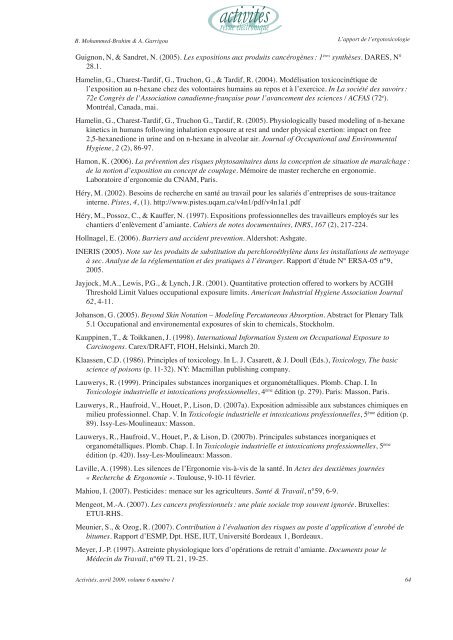Une approche critique du modèle dominant de prévention du risque chimique
Une approche critique du modèle dominant de prévention du risque chimique
Une approche critique du modèle dominant de prévention du risque chimique
You also want an ePaper? Increase the reach of your titles
YUMPU automatically turns print PDFs into web optimized ePapers that Google loves.
B. Mohammed-Brahim & A. Garrigou<br />
revue électronique<br />
L’apport <strong>de</strong> l’ergotoxicologie<br />
Guignon, N, & Sandret, N. (2005). Les expositions aux pro<strong>du</strong>its cancérogènes : 1 ères synthèses. DARES, N°<br />
28.1.<br />
Hamelin, G., Charest-Tardif, G., Truchon, G., & Tardif, R. (2004). Modélisation toxicocinétique <strong>de</strong><br />
l’exposition au n-hexane chez <strong>de</strong>s volontaires humains au repos et à l’exercice. In La société <strong>de</strong>s savoirs :<br />
72e Congrès <strong>de</strong> l’Association canadienne-française pour l’avancement <strong>de</strong>s sciences / ACFAS (72 e ).<br />
Montréal, Canada, mai.<br />
Hamelin, G., Charest-Tardif, G., Truchon G., Tardif, R. (2005). Physiologically based mo<strong>de</strong>ling of n-hexane<br />
kinetics in humans following inhalation exposure at rest and un<strong>de</strong>r physical exertion: impact on free<br />
2,5-hexanedione in urine and on n-hexane in alveolar air. Journal of Occupational and Environmental<br />
Hygiene, 2 (2), 86-97.<br />
Hamon, K. (2006). La <strong>prévention</strong> <strong>de</strong>s <strong>risque</strong>s phytosanitaires dans la conception <strong>de</strong> situation <strong>de</strong> maraîchage :<br />
<strong>de</strong> la notion d’exposition au concept <strong>de</strong> couplage. Mémoire <strong>de</strong> master recherche en ergonomie.<br />
Laboratoire d’ergonomie <strong>du</strong> CNAM, Paris.<br />
Héry, M. (2002). Besoins <strong>de</strong> recherche en santé au travail pour les salariés d’entreprises <strong>de</strong> sous-traitance<br />
interne. Pistes, 4, (1). http://www.pistes.uqam.ca/v4n1/pdf/v4n1a1.pdf<br />
Héry, M., Possoz, C., & Kauffer, N. (1997). Expositions professionnelles <strong>de</strong>s travailleurs employés sur les<br />
chantiers d’enlèvement d’amiante. Cahiers <strong>de</strong> notes documentaires, INRS, 167 (2), 217-224.<br />
Hollnagel, E. (2006). Barriers and acci<strong>de</strong>nt prevention. Al<strong>de</strong>rshot: Ashgate.<br />
INERIS (2005). Note sur les pro<strong>du</strong>its <strong>de</strong> substitution <strong>du</strong> perchloroéthylène dans les installations <strong>de</strong> nettoyage<br />
à sec. Analyse <strong>de</strong> la réglementation et <strong>de</strong>s pratiques à l’étranger. Rapport d’étu<strong>de</strong> N° ERSA-05 n°9,<br />
2005.<br />
Jayjock, M.A., Lewis, P.G., & Lynch, J.R. (2001). Quantitative protection offered to workers by ACGIH<br />
Threshold Limit Values occupational exposure limits. American In<strong>du</strong>strial Hygiene Association Journal<br />
62, 4-11.<br />
Johanson, G. (2005). Beyond Skin Notation – Mo<strong>de</strong>ling Percutaneous Absorption. Abstract for Plenary Talk<br />
5.1 Occupational and environemental exposures of skin to chemicals, Stockholm.<br />
Kauppinen, T., & Toikkanen, J. (1998). International Information System on Occupational Exposure to<br />
Carcinogens. Carex/DRAFT, FIOH, Helsinki, March 20.<br />
Klaassen, C.D. (1986). Principles of toxicology. In L. J. Casarett, & J. Doull (Eds.), Toxicology, The basic<br />
science of poisons (p. 11-32). NY: Macmillan publishing company.<br />
Lauwerys, R. (1999). Principales substances inorganiques et organométalliques. Plomb. Chap. I. In<br />
Toxicologie in<strong>du</strong>strielle et intoxications professionnelles, 4 ème édition (p. 279). Paris: Masson, Paris.<br />
Lauwerys, R., Haufroid, V., Houet, P., Lison, D. (2007a). Exposition admissible aux substances <strong>chimique</strong>s en<br />
milieu professionnel. Chap. V. In Toxicologie in<strong>du</strong>strielle et intoxications professionnelles, 5 ème édition (p.<br />
89). Issy-Les-Moulineaux: Masson.<br />
Lauwerys, R., Haufroid, V., Houet, P., & Lison, D. (2007b). Principales substances inorganiques et<br />
organométalliques. Plomb. Chap. I. In Toxicologie in<strong>du</strong>strielle et intoxications professionnelles, 5 ème<br />
édition (p. 420). Issy-Les-Moulineaux: Masson.<br />
Laville, A. (1998). Les silences <strong>de</strong> l’Ergonomie vis-à-vis <strong>de</strong> la santé. In Actes <strong>de</strong>s <strong>de</strong>uxièmes journées<br />
« Recherche & Ergonomie ». Toulouse, 9-10-11 février.<br />
Mahiou, I. (2007). Pestici<strong>de</strong>s : menace sur les agriculteurs. Santé & Travail, n°59, 6-9.<br />
Mengeot, M.-A. (2007). Les cancers professionnels : une plaie sociale trop souvent ignorée. Bruxelles:<br />
ETUI-RHS.<br />
Meunier, S., & Ozog, R. (2007). Contribution à l’évaluation <strong>de</strong>s <strong>risque</strong>s au poste d’application d’enrobé <strong>de</strong><br />
bitumes. Rapport d’ESMP, Dpt. HSE, IUT, Université Bor<strong>de</strong>aux 1, Bor<strong>de</strong>aux.<br />
Meyer, J.-P. (1997). Astreinte physiologique lors d’opérations <strong>de</strong> retrait d’amiante. Documents pour le<br />
Mé<strong>de</strong>cin <strong>du</strong> Travail, n°69 TL 21, 19-25.<br />
Activités, avril 2009, volume 6 numéro 1 64


